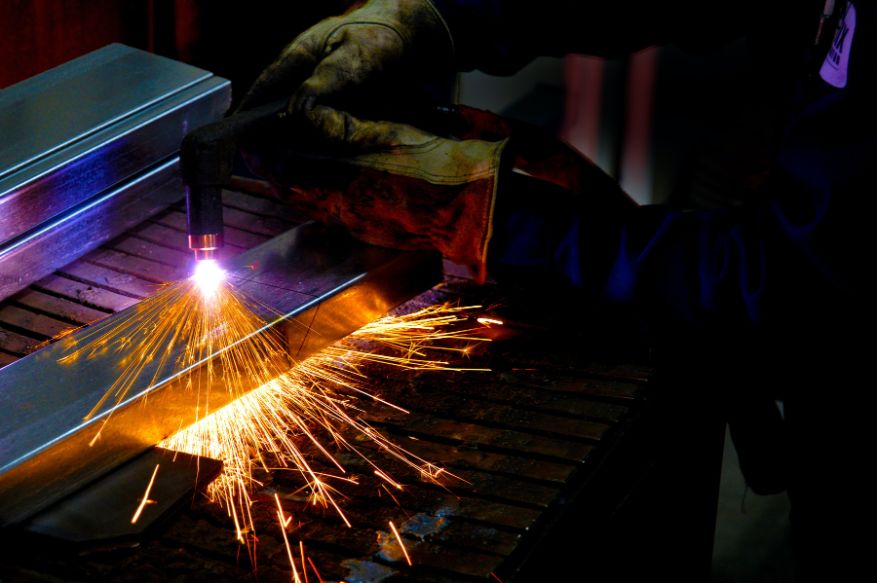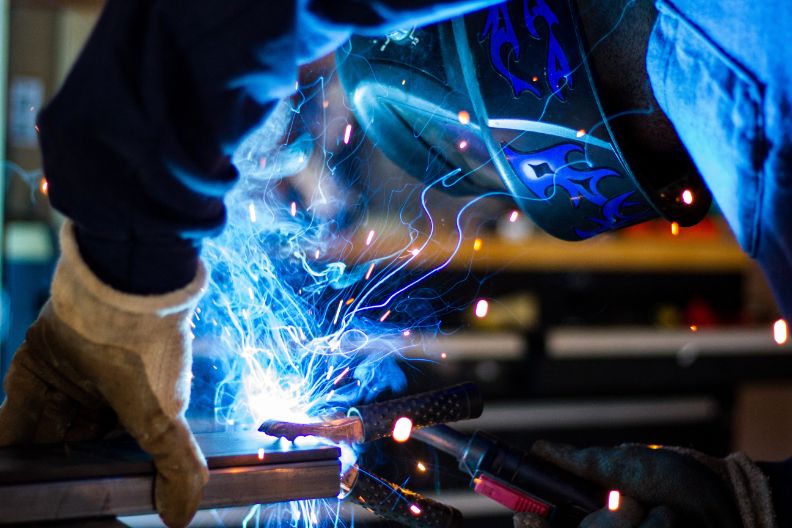Welding is a demanding career, but if you are a person who likes to work with your hands and create or repair things, welding might be the career path for you. Before we discuss a day in the life of a welder, let’s first answer the question: what is welding?

Welding is a process of fabrication where two parts (or more) are fused together by using heat, pressure, or both. When we think of welding, we usually think it’s just for metals, but thermoplastics and even wood can be welded together. This fusion process (for metals) is mostly done with a blowtorch or an electric arc.
You will learn all about welding processes and techniques if you enroll in a welding program at a technical learning institute. A welding diploma takes about a year and reputable schools include certification exams that will help you get the job you want.
Can You Learn to Weld On-The-Job?
You might be asking yourself: “Can I learn to weld on-the-job?” The answer is that while you might learn on the job, you will only learn to complete the tasks your employer gives you. You will not have the range of skills that a formal training program will include, which will likely make you a better welder right from the start. Finding another job as a welder might be difficult if you only know how to perform one specific set of tasks. So, taking a year to learn the trade is a good investment in yourself. Especially because you can train in your field and hold down a part-time job as well.

Where Do Welders Work?
In general terms, you’ll find welders wherever things are built or repaired. You might work outdoors on construction sites, or you might work indoors in factories or repair shops. You might even work in boatyards or oilfields. You’ll have a variety of work environments from which to choose.
Another question you might have is: “Is welding the right kind of work for me?” Here are some traits of welders:
- Work as a team on a big project OR work alone for long periods of time
- Can adhere to strict safety procedures
- Can work on your feet for long periods of time
- Able to lift heavy objects (at least 50 pounds regularly)
- Able to tolerate extreme environments when it comes to heat and noise
The best part of the welding trade is that the job outlook is good according to the U.S. Bureau of Labor Statistics. Many welding schools, like the one at the Institute of Medical and Business Careers, have partnerships for welding students to obtain internships with local employers. This improves the chances that you’ll be working soon after graduation.
Now, let’s look at a day in the life of a welder who works in a large factory that produces doors for semi-truck containers.
A Typical Day Welding in a Manufacturing Plant
Start of shift
In many cases, welders work in shifts. For our welder, he works the evening shift, which is typically 10 hours per day, four days per week. He’ll clock in upon arrival at the worksite, place personal items such as jackets, hats, bags, and lunches into a secure locker, and then change into protective gear. Protective gear includes heat or fire-resistant gloves, leather or fire-retardant protective clothing and boot covers, an N95 mask, a face covering, and a protective helmet. He might wear earplugs or wear industrial noise-canceling headphones.
Afterward, he’ll head toward the assigned workspace, review previously completed work, and prepare workbenches, the workspace, and equipment. At this time, welders will run through a checklist of safety procedures on their equipment.

Welding Begins
Once his safety checks are complete, he’ll consult the work order and client order list to ensure everything is clear and accurate and that there are no irregularities. Then, he’ll select the tools and equipment necessary to complete the tasks on that list.
Finally, he’ll start welding. If non-conformities (mistakes, errors, wrong materials, etc.,) occur, he’ll contact the supervisor. He will also contact the supervisor or team leader to sign off when the task is completed. Communication, especially when issues arise, is extremely important in welding, to avoid potential hazards or flawed work. An improper weld can become a safety risk.
Once the supervisor has signed off the task, he will move on to the next welding task on the list. If he needs to, he’ll change workstations to comply with workflow procedures.
One thing that is very important: welders must remember to stay hydrated at all times because the work environment and protective gear can be very hot. Multiple mini-breaks for hydration and rest are permitted, but these mini-breaks are taken at the workstation and are typically under five minutes. Personal protective equipment (PPE) is typically not removed; PPE is only removed for regular breaks and at the end of the shift. For this reason, welders often have large coolers of ice water they bring with them each day, and refill at the workplace.
End of Day
When the shift is just about over, the welder will clean his workstation and work area as well as reset equipment as per factory protocols, to make sure everything is ready for the next shift. He will go to the locker in the changing room, remove personal protective equipment, and change clothes. Equipment may require cleaning, per employer protocols. Personal items will be retrieved and then the welder clocks out and then exits the facility.
The Take-Away
If you like working with your hands in a team-driven environment and don’t mind the heat and noise, consider welding. You’ll be involved in the manufacturing process, responsible for making new things or repairing damaged ones, making them as good as new. Most welders agree that they find the job satisfying. The job outlook is strong, and you can work indoors or outdoors in a wide variety of manufacturing settings.
You can learn on the job, but as mentioned above, keep in mind that you may be limiting yourself to a smaller skill set that may not be as transferrable to another employer. That means it might not be easy to find another job if you are unhappy with your current employer. So, rather than learn on the job, consider earning a welding diploma. This will widen your career options and you will have better chances at finding work you are passionate about.
Overall, take the first step to find your welding S.P.A.R.K. and visit the Institute of Medical and Business Careers today to learn more.
